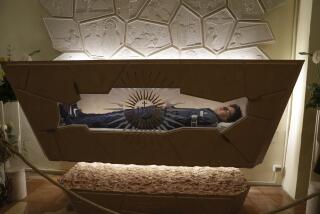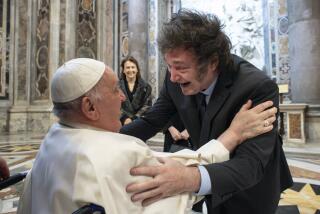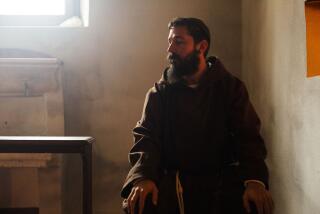Beloved Pio Becomes a Saint
- Share via
VATICAN CITY — Pope John Paul II made it official Sunday: Padre Pio, long regarded by followers as a saint, was canonized in a ceremony at St. Peter’s Square that drew one of the largest crowds ever for such an event.
The day marked an extraordinary comeback for the widely beloved Capuchin friar, who died in 1968 at 81. He was believed by many to carry the crucifixion wounds of Christ but was repeatedly investigated by the Vatican as a suspected fraud or sexual wrongdoer.
One of the most popular Roman Catholic figures of the 20th century, Padre Pio was said during his lifetime to be able to grant miracles, predict the future, read people’s minds and be in two places at once. His supporters also saw him as a deeply holy man who inspired huge numbers of people to greater faith--the characteristic for which John Paul seemed most intent on honoring him.
About 300,000 pilgrims and residents of Rome turned out under a blazing sun to participate in his elevation to sainthood, police said. The huge crowds assembled in and around St. Peter’s Square, on roads leading to the Vatican and at another square where a giant television screen carried the 2 1/2-hour ceremony live.
Padre Pio “loved to repeat, ‘I’m a poor friar who prays,’ ” John Paul said in his homily. The new saint was “convinced that ‘prayer is the best weapon we have, a key that opens the heart of God.’ ”
John Paul, dressed in gold and white vestments, also recalled how in 1947, as a young priest, he had journeyed from his native Poland so that Padre Pio could hear his confession.
“We register him in the list of saints and establish that throughout the church he be devotedly honored,” the pontiff declared, to the applause of his listeners.
Most seemed thrilled to be present despite the discomfort, but medical workers tended to hundreds on the spot and took dozens to hospitals, mainly to treat effects of the heat. Toward the end of the ceremony, workers used huge water hoses to spray the crowd, and hundreds of thousands of free containers of drinking water were distributed, some labeled “Saint Padre Pio.”
Civil defense officials said the temperature in the square climbed to 97.
John Paul, 82, who suffers from Parkinson’s disease and is very frail, was sheltered from the sun by a canopy over the altar set on the steps of St. Peter’s Basilica. Despite the heat, he spoke at length, showing greater endurance than he had at any of his appearances on a May trip to Azerbaijan and Bulgaria.
The pontiff read out a prayer he composed asking Padre Pio to “sustain us in the hour of combat and trial” and urging that he teach believers to “recognize the face of Christ in those who suffer and the poor.”
Padre Pio’s life showed that “difficulties and pains, if accepted for love, are transformed into a privileged path toward holiness,” John Paul said.
Named Francesco Forgione at birth, Padre Pio was in his teens when he joined the Capuchins, a Franciscan order known for vows of poverty. Both his fame and the controversy that swirled around him began in 1918, when word spread that he had been marked by stigmata--wounds on his hands, feet and side similar to those of Jesus on the cross.
Over the decades, some popes respected him and others were suspicious. Doubt was cast on his stigmata, which his followers said were a sign of holiness that he bore until death. He was banned at times from saying Mass or hearing confessions.
In the early 1960s, under Pope John XXIII, an investigation reported allegations that Padre Pio was having sexual relations with female devotees. After his death, another Vatican investigation cleared him of those charges.
A biography in a booklet used for Sunday’s ceremony cited his ever-greater popularity as a sign that he deserved sainthood.
“In the years following his death, his reputation for sanctity and miracles grew steadily and became established in the church all over the world and among all kinds of people,” it said. “God thus showed the church his desire to glorify on earth his faithful servant.”
For sainthood, the Vatican requires certification of two miracles attributed to the figure’s intercession after his or her death, one for beatification and one for canonization. In the case of Padre Pio, the first miracle was the unexplained 1995 recovery of an Italian woman with a chest ailment, and the second was the 2000 recovery of a boy from a meningitis-induced coma.
Luca Frattura, 38, was among those at St. Peter’s Square who came with a personal plea.
“People need assurances that the world doesn’t give, but Padre Pio does,” Frattura said. “Because my wife is sick, I also want to ask for something.”
Frattura said that while prayers don’t always seem to be answered, “suffering ... doesn’t have to be understood as a negative thing.” It can be “a cross” that brings salvation, and “that is the miracle,” he said.
Asked what Padre Pio means to her, Giuliana Anania, 54, replied, “Everything: life, love, peace, serenity.”
“He did many miracles, so many people believe in him,” said her friend, Caterina Fragale, 41.
The two women had arrived at St. Peter’s Square at 6 a.m. for the 10 a.m. ceremony but were already too late to get inside, Fragale said. They finally made it in about half an hour before the service ended. Asked how they did it, she replied: “We prayed. We prayed to a policeman.”
More to Read
Sign up for Essential California
The most important California stories and recommendations in your inbox every morning.
You may occasionally receive promotional content from the Los Angeles Times.










